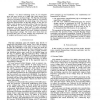Free Online Productivity Tools
i2Speak
i2Symbol
i2OCR
iTex2Img
iWeb2Print
iWeb2Shot
i2Type
iPdf2Split
iPdf2Merge
i2Bopomofo
i2Arabic
i2Style
i2Image
i2PDF
iLatex2Rtf
Sci2ools
ISQED
2008
IEEE
2008
IEEE
An Implementation of Performance-Driven Block and I/O Placement for Chip-Package Codesign
– As silicon technology scales, we can integrate more and more circuits on a single chip, which means more I/Os are needed in modern designs. The flip-chip technology which was developed by IBM is better suited for I/O increase than the typical peripheral wire-bond design. One of the most important characteristics of flip-chip designs is that the I/O buffers could be placed anywhere inside a chip, just like core cells. Motivated by [14] in proposing various I/O planning constraints, we develop a block and I/O buffer placement method in wirelength and signal skew optimization (especially for differential pair signals), and power integrity awareness for chip-package codesign. The results have shown that our approach takes care of power integrity and outperforms [12] in weighted performance metrics optimization.
| Added | 31 May 2010 |
| Updated | 31 May 2010 |
| Type | Conference |
| Year | 2008 |
| Where | ISQED |
| Authors | Ming-Fang Lai, Hung-Ming Chen |
Comments (0)

